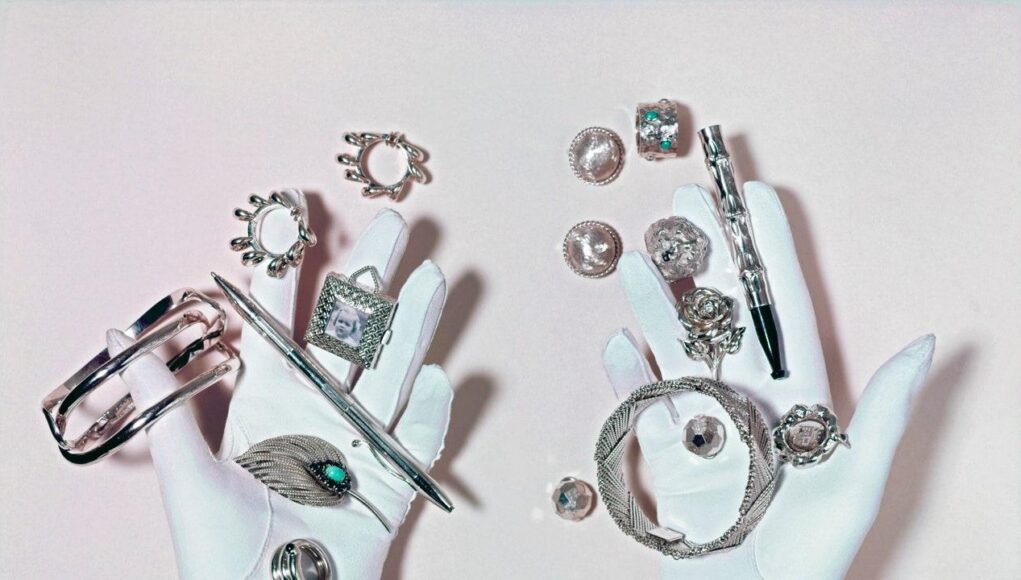“Jewelry is the most transformative thing you can wear,” said the late, great fashion icon Iris Apfel. How to clean jewelry, then, should be an easily answerable and well-attended to question within your fashion vocabulary.
Whether an ornate, gemstone-studded broach, a simple set of gold hoops to wear every day, a family heirloom necklace, or ‘MOM’-emblazoned knuckle rings: Your special pieces deserve to be kept tarnish-free, sparkly, and clean. It doesn’t have to be so complicated, but there’s a few hard and fast rules to stick to when it comes to keeping your jewelry shining. You should first determine exactly what material your jewelry is made from: Gold or gold-plated? Silver or sterling silver? Brass or gemstone? This may affect how you approach your cleaning process, and how often you do it. You can check in, too, on your jewelry manufacturer to see if they have any specific recommendations (brands like Pandora and Mejuri do) or products they advise to use with their pieces.
It’s also good to remember that storing your jewelry correctly is just as important for keeping them tarnish-free and intact: Separate your pieces, keep them cool, and keep them out of direct sunlight. Andraya Kenon, founder and creative director of brand Celeste Starre, says: “Store your pieces separately to keep them gleaming for a lifetime.”
I sought out Emily Nunns, founder of British brand Ballinger (and former Vogue senior strategist), which creates statement, demi-fine jewelry that’s inspired by vintage family heirlooms and all about jewelry that would last. “I wasted lots of money over the years on earrings that would tarnish quickly or rings that would turn my fingers green after just a few wears!” she says. “I’m not even talking about cheap jewelry either, I was buying from expensive brands. Creating Ballinger’s first samples involved lots of trial and error. I work with a father-and-son duo based in Istanbul to bring my jewelry designs to life. The final technique we decided on using is called physical vapor deposition (PVD) which involves vacuum-coating a thick layer of 18 carat gold on top of our base metals. (We use sterling silver and also brass). This technique makes jewelry 10 times stronger than standard gold-plating, so it dramatically enhances its durability. We’ve even run rigorous tests on Ballinger pieces, such as running them through the dishwasher and soaking them in various substances, such as salt water, and we’re yet to find something that has damaged our pieces.”
Here’s someone with hardy knowledge on how to clean jewelry and craft pieces that last. Before we’ve even got to breaking down your jewelry cleaning regimen, a precautionary top tip from Nunns is to put your jewelry on after—not before—applying body lotion, perfume, oils, or SPF. “This will make any type of jewelry easier to clean after wear and generally help to protect it,” she says.
What causes your jewelry to get dull and dirty? It’s usually going to be soaps, lotions, and body oils that create that cloudy, hazy affect. Also, there’s the environment: Pollution, dirt, and dust. Your everyday activities, from swimming to showering, gardening, and just being out in the world can collect grime.
Below is your failsafe guide for how to clean jewelry.
How often should you clean your jewelry?
“Little and often” is Nunns’ rule. “I would recommend wiping down your jewelry a few times a week if you wear it every day,” she says. “Then, once a month, you can do a deeper clean of your favorite pieces. All you will need is warm water, dish soap, a soft toothbrush, and a cloth.” Nunns advises to stay away from alcohol-based cleaners. “I would generally steer clear of using alcohol to clean jewelry. It isn’t necessary and can damage certain materials. Alcohol can also dry out the natural oils in gemstones causing them to look cracked.”
The internet is overrun with varying information, and Nunns also recommends being cautious when it comes to TikTok’s DIY cleaning hacks. “I’ve seen some slightly worrying ones encouraging you to dip your jewelry into harsh household chemicals which I would not recommend!” she says.
How to clean gold and gold-plated jewelry
Solid gold is durable and won’t tarnish. Gold-plated jewelry—where there’s a less expensive metal base coated in a thin layer of gold—can chip. Whatever the case, proceed carefully. Use a mild soap—washing up liquid works just fine, says Nunns—and some warm water. “Mild soap is crucial as anything too harsh can damage your jewelry, so avoid anything containing bleach or chlorine,” Nunns adds. Add a few drops of the soap to a small, warm water bath and carefully place your jewelry inside. You can let it soak for a few minutes. You can also recruit a soft toothbrush into your arsenal. “My top tip is to use a baby toothbrush as they have softer bristles,” she says. “Used wet or dry, a toothbrush can get into crevasses in jewelry that a cloth cannot reach.” Give it a final rinse. Then, once your jewelry is fully dry, buff it with a microfiber cloth. Avoid overcleaning plated pieces.
The most important facet of any jewelry cleaning routine, whatever kind you have, is to be gentle—no scrubbing or aggressive rubbing. That’s especially true for gold-plated or silver-plated pieces.
How to clean silver and sterling silver jewelry
Silver jewelry does tarnish. The main difference in the approach to looking after silver jewelry, Nunns says, is not so much in how you keep it clean, but in that it needs to be stored properly to reduce the risk of tarnishing. “Excessive exposure to air, moisture, and sunlight is what causes silver jewelry to tarnish, so always store silver pieces inside a lined jewelry box,” she explains. With her own brand Ballinger, she has created pretty velvet blue gift boxes that come with every order for your jewelry to be safely and chicly stored in.
You can also invest in some silver polish or foam—like this one from Goddard’s—that helps to remove tarnishing and leaves a protective coating. Be warned, though, this can get a bit messy. You can get some disposable silver polish wipes or keep a cloth just for your polishing to hand.
Need a more DIY method for more intensive tarnishing? You can also try mixing three parts baking sofa to one part water to create a paste, dampening your silver, and running a cloth with the paste over your jewelry. Rinse then buff. A small smear of toothpaste also works here if you don’t have baking soda.
Still, Clare Ngai-Howard, founder and creative director of Bonbonwhims (a whimsical, Y2K-inspired, and AAPI-owned jewelry and accessory brand based in New York City, which utilizes materials from enamel to resin, metals and freshwater pearls) advises: “For our sterling silver pieces, I use a silver polishing cloth, as baking soda sometimes can scratch the metal.”
How to clean fashion and costume jewelry
Costume jewelry or fashion jewelry can fall foul of tarnishing—often, because they’re made from less hardy materials like aluminium, brass, or copper. To keep things as tarnish-free and undamaged as possible, you’ll once again create your dish soap and warm water solution. But this time, don’t think to soak your pieces—doing so could dissolve any gems, glue, or plastics. Instead, take a microfiber cloth and dip it into your soapy water, and run it over your jewelry carefully. Once clean, wipe a clean, soapless cloth over your jewelry, pat it dry, and leave it to air dry on top of a towel.
How to clean jewelry with gems, precious stones or pearls
“The safest way to clean your rings at home is with warm water and a mild dish soap—I use Ivory,” Elizabeth Doyle of Doyle & Doyle, an antique jewelry store in New York’s Meatpacking District, tells Vogue.
For stubborn dirt, soak your rings, bracelets, or stoned necklaces for a while to loosen up the debris. Then, brush them with a soft-bristled toothbrush. “Make sure to get behind your stones in the mountings where dirt and grime can accumulate,” says Doyle. Warning though: Cleansers should not be used on any organic gems, like coral or pearls, or porous stones like opals or turquoise: “The alcohol in the sanitizer can dry out the gems and lead to surface damage or cracking.”
Pearls in particular, you should be extra careful with. “Pearls are incredibly delicate; even washing them in water that is too warm can damage them,” adds Nunns. “Dish soap can make pearls lose their shine, and anything too acidic or abrasive can permanently scratch or damage pearls. I would recommend washing them in just lukewarm water and once air-dried, use a soft cloth to wipe them.”
After daily wear of pieces with gemstones or pearls in them, Nunns would also recommend giving them a quick wipe with a soft cloth a few times a week to remove any oils or perfume build-up from the surface.
And if you’ve sourced some stunning, well-adorned pieces from the Georgian and early Victorian eras, you should also take special care. “Water can get into rings with closed-back mountings and affect the appearance of the stones,” says Doyle. “Also, locket rings or any ring that has a photo of some other decoration under glass should not be washed with water.”
When should you use a professional service?
If you’re worried about damaging a particular piece of jewelry–whether that’s an antique, a sentimental family heirloom, or a more intricate piece—Nunns recommends seeking professional help. “A jeweller will be able to make your piece sparkle again,” she says. “However with your everyday demi-fine jewelry, you shouldn’t need to use a professional service if you clean it yourself at home.”
Keeping your jewelry clean and in top condition
These are some must-do habits to incorporate into your everyday routine with your most loved everyday pieces. Always remove your rings when you’re washing your hands, showering, cleaning your house, doing your makeup or skincare, putting on perfume, or swimming. Invest in anti-tarnish bags or boxes and keep strict on how you store your jewelry. If ever in doubt, consult your local jeweller on particularly sentimental or of-value pieces to inspect their condition and for any extra advice on keeping them in good shape.









